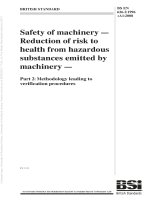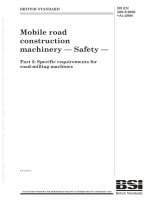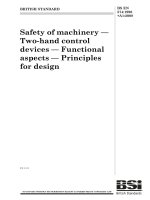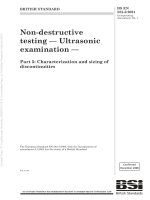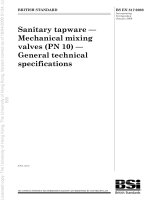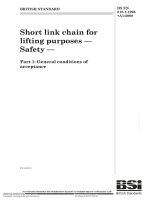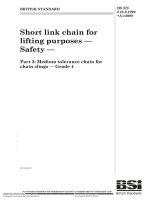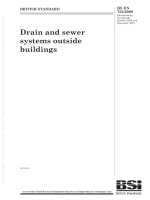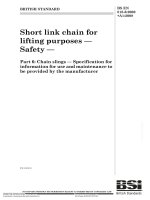Bsi bs en 00528 2008
Bạn đang xem bản rút gọn của tài liệu. Xem và tải ngay bản đầy đủ của tài liệu tại đây (1.11 MB, 80 trang )
BRITISH STANDARD
Rail dependent
storage and retrieval
equipment — Safety
requirements
ICS 53.080
NO COPYING WITHOUT BSI PERMISSION EXCEPT AS PERMITTED BY COPYRIGHT LAW
BS EN 528:2008
BS EN 528:2008
National foreword
This British Standard is the UK implementation of EN 528:2008. It
supersedes BS EN 528:1997 which is withdrawn.
The UK participation in its preparation was entrusted to Technical
Committee MHE/14, Rail dependent storage and retrieval equipment Safety.
A list of organizations represented on this committee can be obtained on
request to its secretary.
This publication does not purport to include all the necessary provisions
of a contract. Users are responsible for its correct application.
Compliance with a British Standard cannot confer immunity
from legal obligations.
This British Standard
was published under the
authority of the Standards
Policy and Strategy
Committee on 31 May
2009.
Amendments/corrigenda issued since publication
Date
Comments
© BSI 2009
ISBN 978 0 580 54853 6
标准分享网 www.bzfxw.com 免费下载
BS EN 528:2008
EUROPEAN STANDARD
EN 528
NORME EUROPÉENNE
EUROPÄISCHE NORM
October 2008
ICS 53.080
Supersedes EN 528:1996
English Version
Rail dependent storage and retrieval equipment - Safety
requirements
Transtockeurs - Prescriptions de sécurité
Regalbediengeräte - Sicherheit
This European Standard was approved by CEN on 24 August 2008.
CEN members are bound to comply with the CEN/CENELEC Internal Regulations which stipulate the conditions for giving this European
Standard the status of a national standard without any alteration. Up-to-date lists and bibliographical references concerning such national
standards may be obtained on application to the CEN Management Centre or to any CEN member.
This European Standard exists in three official versions (English, French, German). A version in any other language made by translation
under the responsibility of a CEN member into its own language and notified to the CEN Management Centre has the same status as the
official versions.
CEN members are the national standards bodies of Austria, Belgium, Bulgaria, Cyprus, Czech Republic, Denmark, Estonia, Finland,
France, Germany, Greece, Hungary, Iceland, Ireland, Italy, Latvia, Lithuania, Luxembourg, Malta, Netherlands, Norway, Poland, Portugal,
Romania, Slovakia, Slovenia, Spain, Sweden, Switzerland and United Kingdom.
www.bzfxw.com
EUROPEAN COMMITTEE FOR STANDARDIZATION
COMITÉ EUROPÉEN DE NORMALISATION
EUROPÄISCHES KOMITEE FÜR NORMUNG
Management Centre: rue de Stassart, 36
© 2008 CEN
All rights of exploitation in any form and by any means reserved
worldwide for CEN national Members.
B-1050 Brussels
Ref. No. EN 528:2008: E
BS EN 528:2008
EN 528:2008 (E)
Contents
Page
Foreword..............................................................................................................................................................5
Introduction .........................................................................................................................................................6
1
Scope ......................................................................................................................................................7
2
Normative references ............................................................................................................................7
3
Terms and definitions ...........................................................................................................................9
4
List of significant and relevant hazards ............................................................................................11
5
5.1
5.2
5.3
5.4
5.5
5.6
5.7
5.8
5.9
5.10
Safety requirements and/or protective measures for all types of S/R machines .........................16
Introduction ..........................................................................................................................................16
Control position ...................................................................................................................................16
Control equipment ...............................................................................................................................16
Hoist unit ..............................................................................................................................................19
Travel unit.............................................................................................................................................26
Load handling devices ........................................................................................................................28
Electrical equipment............................................................................................................................30
Transfer device ....................................................................................................................................31
Maintenance repair and fault clearance ............................................................................................32
Machine environment ..........................................................................................................................34
6
6.1
6.2
6.3
6.4
6.5
6.6
Additional requirements for manual operated machines ................................................................38
General..................................................................................................................................................38
Onboard control position....................................................................................................................38
Control equipment ...............................................................................................................................40
Hoist unit ..............................................................................................................................................41
Acceleration and deceleration............................................................................................................41
Protection of operators in an aisle containing two or more manually operated machines.........41
7
7.1
7.2
7.3
7.4
7.5
7.6
Particular requirements for machines without an on-board operator ...........................................41
General..................................................................................................................................................41
External control position (control desk) ...........................................................................................41
Control equipment ...............................................................................................................................41
Hoist unit ..............................................................................................................................................42
Load handling devices ........................................................................................................................42
Escape ..................................................................................................................................................42
8
8.1
8.2
Installation ............................................................................................................................................42
Erection and dismantling on site .......................................................................................................42
Commissioning ....................................................................................................................................43
9
9.1
9.2
9.3
9.4
9.5
Verification of safety requirements and/or measures......................................................................43
Examination..........................................................................................................................................43
Written record ......................................................................................................................................44
EMC .......................................................................................................................................................44
Noise .....................................................................................................................................................44
Load tests .............................................................................................................................................45
10
10.1
10.2
10.3
10.4
10.5
Information for use ..............................................................................................................................46
General..................................................................................................................................................46
Instruction handbook ..........................................................................................................................46
Minimum markings ..............................................................................................................................47
Conditions for the safe operation of equipment ..............................................................................47
Maintenance, inspection and testing.................................................................................................50
www.bzfxw.com
Annex A (informative) Illustration of types of machines and transfer equipment .....................................52
2
标准分享网 www.bzfxw.com 免费下载
BS EN 528:2008
EN 528:2008 (E)
Annex B (informative) Means of separation within racking..........................................................................54
Annex C (normative) Safety levels according to EN ISO 13849-1................................................................55
Annex D (informative) Examples for the design of load entry/exit points to prevent or deter
access to danger areas or protect persons in accordance with 5.10.4 .........................................63
D.1
General .................................................................................................................................................63
D.2
Measures against access between the conveyor and fixed guard ................................................63
D.3
Load entry/exit opening height ..........................................................................................................63
D.4
Measures which deter access ............................................................................................................65
D.5
Measures that prevent access ...........................................................................................................67
D.6
Protecting devices...............................................................................................................................67
Annex E (normative) Verification of safety requirements and/or measures ..............................................68
Annex ZA (informative) Relationship between this European Standard and the Essential
Requirements of EU Directive Machinery 98/37/EC.........................................................................74
Annex ZB (informative) Relationship between this European Standard and the Essential
Requirements of EU Directive Machinery 2006/42/EC.....................................................................75
Bibliography......................................................................................................................................................76
Figures
Figure A.1 — Examples of rail dependent storage and retrieval equipment .............................................52
Figure A.2 — Examples of transfer equipment .............................................................................................52
www.bzfxw.com
Figure A.3 — Key dependent concept for automatic S/R machines ...........................................................53
Figure B.1 — Means of separation with racking (see 5.10.3.3)....................................................................54
Figure B.2 — Leaving for emergency purposes............................................................................................54
Figure D.1 — Sloping plates............................................................................................................................63
Figure D.2 — Load entry/Exit height up to 0,5 m ..........................................................................................64
Figure D.3 — Load entry/Exit height more than 0,5 m..................................................................................64
Figure D.4 — Design of frame surface ...........................................................................................................65
Figure D.5 — Area between chains of twin chain conveyors ......................................................................66
Figure D.6 — Mechanical guards ....................................................................................................................67
Figure D.7 — Protecting devices ....................................................................................................................67
Tables
Table 1 — List of significant and relevant hazards.......................................................................................11
Table C.1 — Performance levels at the level of safety related parts ..........................................................55
Table C.2 — Performance levels at the level of safety functions ................................................................60
3
BS EN 528:2008
EN 528:2008 (E)
Table E.1 ........................................................................................................................................................... 68
www.bzfxw.com
4
标准分享网 www.bzfxw.com 免费下载
BS EN 528:2008
EN 528:2008 (E)
Foreword
This document (EN 528:2008) has been prepared by Technical Committee CEN/TC 149 “Power-operated
warehouse equipment”, the secretariat of which is held by DIN.
This European Standard shall be given the status of a national standard, either by publication of an identical
text or by endorsement, at the latest by April 2009, and conflicting national standards shall be withdrawn at the
latest by December 2009.
Attention is drawn to the possibility that some of the elements of this document may be the subject of patent
rights. CEN [and/or CENELEC] shall not be held responsible for identifying any or all such patent rights.
This European Standard supersedes EN 528:1996.
EN 528:1996 can be further applied until 12/2009.
This document has been prepared under a mandate given to CEN by the European Commission and the
European Free Trade Association, and supports essential requirements of EU Directive(s) 98/37/EC and
2006/42/EC.
For relationship with EU Directive(s), see informative Annexes ZA and ZB, which are integral parts of this
document.
www.bzfxw.com
According to the CEN/CENELEC Internal Regulations, the national standards organizations of the following
countries are bound to implement this European Standard: Austria, Belgium, Bulgaria, Cyprus, Czech
Republic, Denmark, Estonia, Finland, France, Germany, Greece, Hungary, Iceland, Ireland, Italy, Latvia,
Lithuania, Luxembourg, Malta, Netherlands, Norway, Poland, Portugal, Romania, Slovakia, Slovenia, Spain,
Sweden, Switzerland and the United Kingdom.
5
BS EN 528:2008
EN 528:2008 (E)
Introduction
This standard is a type C standard as stated in EN ISO 12100.
The machinery concerned and the extent to which hazards, hazardous situations and hazardous events are
covered are indicated in the scope of this standard.
When provisions of this type C standard are different from those that are stated in type A or type B standards,
the provisions of this type C standard take precedence over the provisions of the other standards, for
machines that have been designed and built according to the provisions of this type C standard.
While producing this standard it was assumed that:
a) only competent persons operate the machine;
b) components without specific requirements are:
1)
designed in accordance with the usual engineering practice and calculation codes, including all
failure modes;
2)
of suitable mechanical and electrical construction;
3)
made of materials with adequate strength and of suitable quality.
www.bzfxw.com
c)
harmful materials, such as asbestos are not used as part of the machine;
d)
components are kept in good repair and working order, so that the required characteristics remain despite
wear;
e)
by design of the load bearing elements, safe operation of the machine is assured for loading ranging from
zero to 100 % of the rated possibilities;
f)
discussions have taken place between the user and the supplier concerning particular conditions for the
use and places of use of the machinery;
g)
working area is adequately lit;
h)
places of installation allow a safe use of the machine.
6
标准分享网 www.bzfxw.com 免费下载
BS EN 528:2008
EN 528:2008 (E)
1
Scope
This standard applies to all types of S/R machines, restricted to the rails on which they travel within and
outside the aisles, which embody lifting means and may embody lateral handling facilities, for the storage and
retrieval of unit loads and/or long goods such as bar materials and/or for order picking or similar duties. Also
included is the transfer equipment used to change between aisles. Control of machines may range from
manual to fully automatic.
This standard does not apply to free ranging industrial trucks or robots.
References in this standard to racking, buildings and systems only apply where it is necessary to assess the
hazards and risks at their interfaces with S/R machines.
This standard deals with all significant hazards relevant to rail dependent storage and retrieval equipment,
when they are used as intended under the conditions foreseen by the manufacturer (see Clause 4).
This standard applies to machines and equipment that are manufactured after the date of issue of this
standard.
Illustrations of examples of machines and transfer equipment to which this standard applies are shown in
Annex A.
Safety requirements and/or measures in this standard apply to equipment used under indoor conditions.
However, additional risk assessments and safety measures need to be considered for uses in severe
conditions, e.g. freezer applications, high temperatures, loads, the nature of which could lead to a dangerous
situation (e.g. especially brittle loads, explosives), earthquake effects and also contact with foodstuff. Hazards
during decommissioning are not covered.
www.bzfxw.com
This European Standard also deals with the technical requirements for electromagnetic compatibility (EMC).
Noise emitted by these machines is not considered as significant but as a relevant hazard. This means that
the manufacturer of the machine is obliged to carry out noise reduction and indicate the noise level.
2
Normative references
The following referenced documents are indispensable for the application of this document. For dated
references, only the edition cited applies. For undated references, the latest edition of the referenced
document (including any amendments) applies.
EN 81-1:1998, Safety rules for the construction and installation of lifts — Part 1: Electric lifts
EN 349, Safety of machinery — Minimum gaps to avoid crushing of parts of the human body
EN 363, Personal fall protection equipment — Personal fall protection systems
EN 574, Safety of machinery — Two-hand control devices — Functional aspects — Principles for design
EN 614-1, Safety of machinery — Ergonomic design principles — Part 1: Terminology and general principles
EN 795, Protection against falls from a height — Anchor devices — Requirements and testing
EN 894-1, Safety of machinery — Ergonomic requirements for the design of displays and control actuators —
Part 1: General principles for human interactions with displays and control actuators
EN 894-2, Safety of machinery — Ergonomic requirements for the design of displays and control actuators —
Part 2: Displays
7
BS EN 528:2008
EN 528:2008 (E)
EN 982, Safety of machinery — Safety requirements for fluid power systems and their components —
Hydraulics
EN 999, Safety of machinery — The positioning of protective equipment in respect of approach speeds of
parts of the human body
EN 1037, Safety of machinery — Prevention of unexpected start-up
EN 1263-1, Safety nets — Part 1: Safety requirements, test methods
EN 1263-2, Safety nets — Part 2: Safety requirements for the positioning limits
EN 1760-1, Safety of machinery — Pressure sensitive protective devices — Part 1: General principles for the
design and testing of pressure sensitive mats and pressure sensitive floors
EN 1760-2, Safety of machinery — Pressure sensitive protective devices — Part 2: General principles for the
design and testing of pressure sensitive edges and pressure sensitive bars
EN 1760-3, Safety of machinery — Pressure sensitive protective devices — Part 3: General principles for the
design and testing of pressure sensitive bumpers, plates, wires and similar devices
EN 12385-4, Steel wire ropes — Safety — Part 4: Stranded ropes for general lifting applications
EN 13411-3, Terminations for steel wire ropes — Safety — Part 3: Ferrules and ferrule-securing
EN 13411-6, Terminations for steel wire ropes — Safety — Part 6: Asymmetric wedge socket
www.bzfxw.com
EN 60204-32:1998, Safety of machinery — Electrical equipment of machines — Part 32: Requirements for
hoisting machines (IEC 60204-32:1998)
EN 60947-5-1:2004, Low voltage switchgear and controlgear — Part 5-1: Control circuit devices and switching
elements — Electromechanical control circuit devices (IEC 60947-5-1:2003)
EN 61000-6-2, Electromagnetic compatibility (EMC) — Part 6-2: Generic standards — Immunity for industrial
environments (IEC 61000-6-2:2005)
EN 61496-1, Safety of machinery — Electro-sensitive protective equipment — Part 1: General requirements
and tests (IEC 61496-1:2004, modified)
EN ISO 4871:1996, Acoustics — Declaration and verification of noise emission values of machinery and
equipment (ISO 4871:1996)
EN ISO 11202, Acoustics — Noise emitted by machinery and equipment — Measurement of emission sound
pressure levels at a work station and at other specified positions — Survey method in situ (ISO 11202:1995)
EN ISO 12100-1:2003, Safety of machinery — Basic concepts, general principles for design — Part 1: Basic
terminology, methodology (ISO 12100-1:2003)
EN ISO 12100-2:2003, Safety of machinery — Basic concepts, general principles for design — Part 2:
Technical principles (ISO 12100-2:2003)
EN ISO 13849-1:2008, Safety of machinery — Safety-related parts of control systems — Part 1: General
principles for design (ISO 13849-1:2006)
EN ISO 13850:2008, Safety of machinery — Emergency stop — Principles for design (ISO 13850:2006)
EN ISO 13857:2008, Safety of machinery — Safety distances to prevent hazard zones being reached by
upper and lower limbs (ISO 13857:2008)
8
标准分享网 www.bzfxw.com 免费下载
BS EN 528:2008
EN 528:2008 (E)
EN ISO 14122-3:2001, Safety of machinery — Permanent means of access to machinery — Part 3: Stairs,
stepladders and guard-rails (ISO 14122-3:2001)
EN ISO 14122-4, Safety of machinery — Permanent means of access to machinery — Part 4: Fixed ladders
(ISO 14122-4:2004)
ISO 4308-1, Cranes and lifting appliances — Selection of wire ropes — Part 1: General
3
Terms and definitions
For the purposes of this document, the terms and definitions given in EN ISO 12100-1:2003 and the following
apply.
3.1
control position
every place, from where the machine can be controlled, including external control position (3.2.), emergency
control position (3.3) and onboard control position (3.4)
3.2
external control position
control position placed in a safe area, out of the working area of the S/R machine, from where the movements
of the machine can be controlled
3.3
emergency control position
position on the machine or inside the danger area of the machine, from where the machine can be controlled
in case of fault clearing (emergency) or maintenance works
www.bzfxw.com
3.4
onboard control position
protected position on the machine, from where the movements of the machine can be controlled (includes S/R
machines according to Clause 6 (with on-board operators))
3.5
operators work area
area on or off the machine where order picking, stocktaking or similar work is carried out
3.6
load handling device
part of the machine for carrying the specified loads
3.7
deterring/impeding device
any physical obstacle which, without totally preventing access to a danger zone, reduces the probability of
access to this zone by offering an obstruction to free access
3.8
rated load
maximum load which the machine has been designed to carry, excluding the mass of operator(s) and any part
of the machine
3.9
test load
rated load plus additional load for test purposes
3.10
rated speed
maximum speed of the machine for which it has been designed and for which normal operation is guaranteed
by the vendor
9
BS EN 528:2008
EN 528:2008 (E)
3.11
safety gear
mechanical device for stopping and maintaining stationary the lifting carriage in case of overspeed in the
downward direction
3.12
specified load
load with specified characteristics (mass, dimensions, pallet or container, packaging, etc.) which the machine
has been designed to carry
3.13
transfer device
device which is used for transferring a S/R machine from one aisle to another and which is not integral with
the S/R machine
3.14
maintenance position
position on or off the machine for safe maintenance and repair
3.15
key
device that can be mechanical, electrical, magnetic or similar with unique characteristics
3.16
maximum working pressure
maximum pressure corresponding to the setting of the pressure relief valve
3.17
operating pressure
pressure under which the system is designed to work
www.bzfxw.com
3.18
satellite vehicle
individual vehicle connected to the lifting carriage of the machine and used for transferring loads into or out of
the rack structure
3.19
load transfer area
area where loads are transferred into or out of the machine operating area
3.20
work station
place where persons carry out their duties
3.21
traffic area
area that personnel use for travel from one place to another
3.22
system axes
directions, in which the sr-machine can move
NOTE
x = aisle length direction; y = aisle vertical direction; z = aisle lateral direction
10
标准分享网 www.bzfxw.com 免费下载
BS EN 528:2008
EN 528:2008 (E)
4
List of significant and relevant hazards
This clause contains all the significant and relevant hazards as far as they are dealt with in this standard,
identified by risk assessment significant for this type of machinery and that require action to eliminate or
reduce risk.
Table 1 — List of significant and relevant hazards
Hazards
Corresponding requirements
4.1
Mechanical hazards
4.1.1
Crushing from collapse of racking due to
contact with the machine
4.1.2
4.1.3
5.4.6.6
Unintentional lowering
5.6.2
End stops
5.6.3
Limitation of forces
5.6.5
Load handling interlocks
5.10.2
Safety clearances
Shearing of a person on board between
moving machine and racking
5.9.2
Maintenance position
6.3.2/7.2
Safeguard of the operator
Cutting due to broken glass
6.2.2.3
6.2.2.10
Safety glass
6.2.4.2
Protected lighting
www.bzfxw.com
4.1.4
Drawing-in or trapping of a person in a
maintenance position when machine
operated by a driver
5.9.5
Communication
4.1.5
Impact from:
6.2.2.3
Floor of the onboard control position
a) Fall of objects from operator's position
5.9.6
Protection from operating machines
b) Collision between machine and persons
5.10.3
Limiting access
5.10.4
Load entry/exit
5.10.6
Escape
6.6
Protection of operators in an aisle
containing two or more manually
operated machines
10.4.6
Operator check of aisle
10.4.7
No unauthorised access to the aisles
10.4.8
Permit to work system
10.5.2.9
No danger from second machine
5.5.5
5.8.5
Stability
5.6.1
Load stability
5.10.3.2.
c)
Access door interlock
6.2.2.3
Horizontal slip-resistant floor
4.1.6
4.1.7
Loss of stability
Slip, trip or fall on operator's platform
11
BS EN 528:2008
EN 528:2008 (E)
Table 1 (continued)
Hazards
4.1.8
4.1.9
4.1.10
Corresponding requirements
Handling of machine
Falling objects
Fall of person from elevated operator
position
5.1
Lifting points
8.1
Erection and dismantling
5.4.7.2
No separation of lifting carriage
5.4.8.2
No rack and pinion disengagement
6.2.2.8
Overhead protection
6.2.1.4
Prevention of falls from access means
6.2.2.3
Floor design
6.2.2.4
Safe guard
6.2.2.5
Guards
6.2.2.6
Permanent fixed guards
6.2.2.7
Operator's position door opening
10.4.15
Operator entering or leaving the
machine in position
10.4.20
Person on load handling device
4.1.11
Defective stopping
5.5.1.1.c)
Emergency braking system
4.1.12
Uncontrolled movements (including
unintended movements)
5.3.5
Control devices for powered
movements
5.3.9
Safety requirements related to EMC
5.4.6.5
Prevention of lowering of the onboard
control position
5.4.2
Limitation of lifting and lowering
movement
5.4.6.7
Auxiliary hoist valve
5.6.1
Load stability
5.6.6
Auxiliary handling equipment
5.6.7
Load position monitoring
5.10.5
Load movement over persons
5.10.7
No unintentional load movement
5.10.8
Protection from falling loads
7.4.3
Lead-screw drives (safety nut)
10.4.10
No overloading
10.4.11
Load remains on load handling device
10.4.12
No projection of goods into aisle
10.4.18
No handling of faulty loads
5.5.2.c)
Speed reducing system
5.5.3.d)
Limitation of travel
5.4.3.1
Overload protection
4.1.13
4.1.14
4.1.15
www.bzfxw.com
Load falls
Collisions
Tipping of machine
12
标准分享网 www.bzfxw.com 免费下载
BS EN 528:2008
EN 528:2008 (E)
Table 1 (continued)
Hazards
4.1.16
Corresponding requirements
Lifting of persons resulting in:
5.5.2
Speed reducing system
5.5.4
Anti-derailment device
5.5.5
Stability
5.6.5
Load handling interlocks
5.8.1
Machine position on transfer device
5.8.3
Transfer device movement
5.8.4
Machine interlocking before transfer
5.8.5
Stability of transfer device
6.4.1
Overload protection
5.4.4
Safety gear
a)
plummeting of onboard control position 5.4.6
Hydraulic lowering control valve
b)
falling from onboard control position
5.4.7
Lead-screw drives (safety nut)
5.4.8
Rack and pinion drives
5.9.2
Protection of maintenance position
6.2.2
Onboard control position design
www.bzfxw.com
10.4.4
Correct numbers of persons on
machine
4.1.17
Derailment of machine
5.5.4
Anti-derailment device
4.1.18
Insufficient strength of parts
5
Compliance with EN standards
4.1.19
Inadequate design of pulleys and drums
5.4.5.1.4 Pulley and drum design requirements
5.4.5.1.5
5.4.5.1.9
5.4.5.1.10
4.1.20
Inadequate selection of suspension
elements
5.4.5.1
5.4.5.2
5.4.5.3
Rope, belt and chain selection criteria
4.1.21
Lowering by friction brake
5.4.1
Hoist unit brake
4.2
Electrical hazards
4.2.1
Electrical contact with live conductors
5.1
Compliance with EN standards
5.7.1
Electrical supply conditions
5.7.3
Environment
5.7.4
Supply disconnecting device
4.2.2
Electrostatic phenomena
Not applicable
4.2.3
Thermal radiation
Not applicable
4.2.4
External influences
Not applicable
4.2.5
Lightning
Not applicable
13
BS EN 528:2008
EN 528:2008 (E)
Table 1 (continued)
Hazards
Corresponding requirements
4.3
Thermal hazards
4.3.1
Burns and scalds
4.3.2
Hot or cold working environment
4.3.3
Inadequate cab heating/ventilation
Not applicable
4.3.4
Fire at the operator control position
6.2.2.9
Furnishings difficult to ignite
4.4
Noise
4.4.1
Hearing loss
5
Protection from hearing loss
4.4.2
Interference with communication
5.9.5
Means of communication
4.5
Vibration
5.10.7
Protection against unintended load
movement
4.6
Radiation
Not applicable
4.7
Materials and substances
5
Specified working environment
4.8
Neglecting ergonomic principles
4.8.1
Unhealthy postures or efforts
6.2.2.1
Ergonomic principles
4.8.2
Inadequate consideration of anatomy
6.2.2.1
Ergonomic principles
4.8.3
No personal protection equipment
8.1.3
Provision of personal protection
equipment
4.8.4
Inadequate lighting
6.2.2.2
Operator view of his area
6.2.4.3
Emergency lighting for evacuation
Not applicable
Extreme thermal conditions: Additional
risk assessment needed
www.bzfxw.com
4.8.5
Mental overload or underload
Not applicable
4.8.6
Human error resulting in:
5.3.2
Equipment switch
a)
unauthorised persons on machines;
10.2.4
Warning signs
b)
dangerous change to automatic
control.
5.3.3
Mode switch
5.3.4
Key dependence
5.7.2
Electrical supply conditions
10.5.2.5
Switch off and lock main isolator
10.5.2.6
Avoid hazards when switching on
power
4.8.7
Lack of visibility
6.2.2.2
Operator view of his area
4.8.8
Inadequate signs/signals/warnings
6.2.3
Operator's warning device
4.8.9
Control devices
5.3.5
Control device for powered
movements
5.3.6
Control device
5.9.3
Emergency controls
5.9.2
Maintenance position
5.9.7
Access along the mast
6.2.1.2
Access to onboard control position
4.8.10
Means of access
14
标准分享网 www.bzfxw.com 免费下载
BS EN 528:2008
EN 528:2008 (E)
Table 1 (continued)
Hazards
Corresponding requirements
4.8.11
Use in dark places
4.9
Hazard combinations
4.9.1
Insufficient evacuation means
4.9.2
4.9.3
Insufficient instructions
Unauthorised use
6.2.4.1
Adequate lighting for work area
6.2.1.3
Safe emergency egress
10.4.16
Immediate evacuation in emergency
8.1.1
Correct assembly information
8.2.1
Correct commissioning information
8.2.2
Instruction manual for commissioning
10.4
Conditions for the safe operation of
equipment
5.3.1
Prevention of unauthorised operation
10.5.2.10
Machine recovery procedure
8.1.2
Trained personnel for erection etc.
8.2.3
Trained personnel for commissioning
10.4.3
Suitable and reliable operators only
10.4.13
Removal of key for manually controlled
machines
www.bzfxw.com
10.4.14
Only one key for automatic machines
4.10
Functional disorders
4.10.1
Failure of energy supply
5.5.1.1.b)
Automatic braking with power failure
4.10.2
Unexpected ejection of fluids
5.4.6.1
5.4.6.2
Pipe and hose pressures
5.4.6.4
Pressure relief valve
4.10.3
Malfunction of control system
5
Compliance with EN standards
4.10.4
Unexpected loss of machine stability
5.5.4.4
10 mm drop if wheel fails
4.11
Missing or incorrectly positioned safety related means
4.11.1
Safety related devices
4.11.2
4.11.3
Starting and stopping devices
Safety signs and signals
5.10.3.3
Sensing devices
5.10.4
Load entry and exit
8.2.4
Check safety devices before
commissioning
10.4.5
Behaviour in case of failures
10.4.9
Safety devices to remain operational
10.5.3.5
Examination of safety components
5.5.1
Braking system
5.5.2
Speed reducing system
5.5.3
Limitation of travel
5.8.4
Stop machine from leaving aisle
10.3.1
Identification plate
15
BS EN 528:2008
EN 528:2008 (E)
Table 1 (continued)
Hazards
Corresponding requirements
10.3.2
Carrying capacity
10.3.4
Warning signs
4.11.4
Information and warning devices
10.3.3
Operating instructions
4.11.5
Energy supply disconnection devices
5.7.4.
Supply disconnecting (isolating) device
4.11.6
Emergency devices
5.3.7
Stop function
7.3.2
Emergency stop equipment
5.5.1
Travel unit braking system
10.5.2.10
Machine recovery procedure
5.7.4
Supply disconnecting (isolating) device
5.9.2
Maintenance position
5.9.3
Emergency control position
5.9.5
Communication means
8.1.3
Correct tools etc. for assembly
4.11.7
4.11.8
5
Equipment for safe adjustment and
maintenance
Equipment for evacuating gases
Not applicable
Safety requirements and/or protective measures for all types of S/R machines
5.1
Introduction
www.bzfxw.com
Machinery shall comply with the safety requirements and/or protective measures of this clause, Clause 6,
Clause 7 and Clause 8. In addition, the machine shall be designed according to the principles of
EN ISO 12100 (all parts) for relevant but not significant hazards, which are not dealt with by this standard.
Controls and other electrical components shall be in accordance with EN ISO 13849-1, EN ISO 13850 and
EN 60204-32 apart from the deviations stated in the following clauses.
Machines and sub-assemblies shall be provided with lifting points unless these are not required by design.
5.2
Control position
S/R machines with one or more on-board operators shall have an onboard control position. This may be
mounted on the lifting carriage, move independently of the lifting carriage, or may be mounted in a fixed
position on the machine.
In the case of fully automatically controlled machines an onboard control position may be dispensed with, but
an emergency control position shall be provided for each machine.
5.3
5.3.1
Control equipment
General
The text of 5.3 and its sub-clauses fully replaces and deviates from the text of 9.4 in EN 60204-32:1998 and
its subclauses.
Safety related parts and safety related functions are listed in Table C.1 and Table C.2 respective of Annex C.
Performance levels shall be in accordance with the performance levels required in these tables.
16
标准分享网 www.bzfxw.com 免费下载
BS EN 528:2008
EN 528:2008 (E)
Adjustable safety related parts (e. g. electronic control circuitry, software, safety devices) shall be protected
against access by unauthorised persons (e. g. by the use of access codes, seals, enclosures, tools).
Safety related parts shall be designed, located or protected to withstand foreseeable strain or damage.
The switching contacts of mechanically actuated electrical safety devices shall be the positive opening type as
defined in Clause 3 of EN 60947-5-1:2004. (i.e. “safety switches”).
5.3.2
Prevention of unauthorised operation (equipment switch)
A key operated switch shall be fitted to the control panel of each machine to prevent unauthorised operation.
With the key switch in the "off" position, all movements of the machine shall be prevented (see 5.3.3). It shall
only be possible to remove the key from this switch in the "off" position.
For manual machines this key allows the operator to take control of the machine. In the case of automatic
machines this key, in conjunction with the key in 5.3.3, allow operation of the machine for commissioning, fault
finding or any other work where the machine needs to be operated by manual control.
5.3.3
Changing mode of operation (mode switch)
To prevent danger due to a change from manual to automatic control, or vice versa, one or more key operated
mode switches, or alternative means providing the same level of safety, shall be provided for each automated
machine (see 6.3.1 and 7.3.1). The mode switches are associated with the safety concept of limited access
described in 5.10.3.1 (see also Figure A.3 in Annex A). When a mode switch is actuated, powered motion
shall cease. The machinery shall then remain in a stationary condition. Separate start devices at the external
control position, located if possible in the direct sight of the machine and on the machine (emergency control
position or onboard control position), shall be provided to be actuated and thus restart the machine.
www.bzfxw.com
It shall only be possible to remove the key from the mode switch on the machine in the "automatic" position
and from the mode switch at a control position outside the machine operating area in the "manual" or "off"
position.
5.3.4
Key dependence
For manual machines the door key (see 5.10.3.2.b)) shall be the same key as specified in 5.3.2, or
permanently attached to it. For automatic machines the door key shall be the same key as specified in 5.3.3,
or permanently attached to it. Equivalent key dependent systems, e. g. key transfer systems as described in
Annex E of EN 1088:1995, may be used.
Where one machine is dedicated to one enclosed aisle, then each key shall be unique to a machine and the
access door associated with the machine operating area.
Where machines are not dedicated to one aisle (e. g. machines with transfer devices, curve going machines)
the key shall be unique for each dedicated aisle entrance door. The key for the machines may all be the same
but permanently attached to the entrance door key.
5.3.5
Control devices for powered movements
Control devices for all movements shall be designed and arranged so that they may be actuated easily and
safely and so that the possibility of unintended actuation is avoided.
For machines with fully enclosed on-board control position (see 6.3.2) the stop category may be 2 (see
5.3.7.1). If a stop command is given, powered motion shall cease and the equipment shall then remain in a
stationary condition until the start control device has subsequently been actuated.
17
BS EN 528:2008
EN 528:2008 (E)
5.3.6
Control device identification
Each control device shall be identifiable and clearly marked with the resultant direction of movement in the
language of the country of use or by pictograms where appropriate. The way in which the control devices are
actuated shall, as far as possible, correspond to the particular movement.
NOTE
5.3.7
5.3.7.1
The application of EN 61310-3 is recommended.
Stop function
Stop categories
The stop function shall comply with 9.2.5.3 of EN 60204-32:1998 and 5.2 of EN ISO 13849-1:2008 and shall
be:
category "0" or "1" stop, or
category "2" stop,
as required by the design (see 9.2.2 of EN 60204-32:1998).
5.3.7.2
Initiation of the stop-function
After a stop function has been initiated powered motion shall cease. If a stop control does not cut off the
energy supply (category "2" stop) the stop condition shall be monitored and maintained. The equipment shall
then remain in a stationary condition until a start device has subsequently been actuated.
5.3.8
5.3.8.1
www.bzfxw.com
Emergency stop function
General
The emergency stop function shall comply with EN ISO 13850:2008, 5.3 of EN ISO 13849-1:2008 and shall
be provided to stop the machine without creating additional risks. The stop category 0 or 1 shall be chosen
according to the design of the drives.
NOTE
Stop category 1 may be used for machines with electronically controlled drives (this deviates from 9.2.5.4.2 of
EN 60204-32:1998).
5.3.8.2
Location of actuators
In addition to the requirements of 10.7.1.1 of EN 60204-32:1998 the actuators for the emergency stop function
shall be located in all control positions as a minimum.
NOTE
The provision of actuators for emergency stop function should be considered for other working positions, e. g.
hoist platforms, maintenance platforms, etc.
If an emergency stop device is actuated, the emergency stop function shall be initiated automatically and
powered motion shall cease. The equipment shall then remain in a stationary condition until the emergency
stop device has been reset and the start device has subsequently been actuated.
5.3.8.3
Electronic devices
Programmable electronic equipment or electronic devices (including electronic sub-assemblies) may be used
for emergency stop functions if the devices and equipment are at least in accordance with the requirements of
Annex C.
NOTE
This is not in accordance with 11.3.4 of EN 60204-32:1998.
18
标准分享网 www.bzfxw.com 免费下载
BS EN 528:2008
EN 528:2008 (E)
5.3.9
Safety requirements related to EMC
NOTE
This clause is related to the Machinery Directive.
The machine shall have sufficient immunity to electromagnetic disturbances enabling it to operate as safely as
intended and shall not fail to danger, when exposed to the levels and types of disturbance as specified in
EN 61000-6-2. The manufacturer of the machine shall design, install and wire the equipment and subassemblies, taking into account the recommendations of the supplier(s) of the sub-assemblies, to ensure that
the effects of electromagnetic disturbances generated shall not lead to unsafe operation and/or failure to
danger.
There shall be no loss of performance or degradation of performance that could lead to danger. In particular,
the following losses of performance or degradations of performance shall not occur:
unexpected start-up (see EN 1037);
blocking of an emergency stop command, or resetting of the emergency stop function (see EN ISO 13850
and EN 60204-32);
inhibition of the operation of any safety related circuit including safety related fault detection capabilities.
Information on measures to reduce the effects of electromagnetic disturbances on the machine is given in
4.4.2 of EN 60204-32:1998.
5.4
Hoist unit
5.4.1
5.4.1.1
Hoist unit brake
www.bzfxw.com
General
All hoist units shall be equipped with brakes capable of stopping the movements of the hoist unit with its test
load safely at its rated speed and maintaining it in its stopped position.
If a holding brake is used together with other equivalent devices, the holding brake must be able to stop any
movements in an emergency case with the same conditions as above. In this case limited lifetime of the
holding break is accepted.
Brakes shall be applied automatically when the power supply is interrupted.
5.4.1.2
Arrangement
The hoist unit shall be arranged so that the connection between the brake and the drum or sprocket cannot be
disengaged.
5.4.1.3
Manual brake release lever
When a manual brake release lever is provided, the brake shall be operational when the lever is released.
5.4.2
Limitation of the lifting and lowering movement
In order that lifting and lowering movements are stopped without undue shock, upper and lower limit stops
shall be used to define the extent of the vertical travel. The following shall be provided:
a)
preliminary devices for initiating a controlled stop towards the upper and lower hoist limits when variable
or multi-step drives are used;
b)
control devices (e. g. limit switch or proximity device) which prohibit incorrect hoist direction at the hoist
travel limits;
19
BS EN 528:2008
EN 528:2008 (E)
c)
d)
ultimate limit switches, which shall be of the positive operating type with direct mechanical actuation in
accordance with EN 60947-5-1. If an ultimate limit switch is activated, an emergency stop function in
accordance with 5.3.6 shall be initiated automatically. The actuators of theses switches shall be
independent of other switches.
1)
Machines with slack rope, chain or belt protection do not require ultimate limit switches for the bottom
limit except for continuous rope and chain drives;
2)
time delay within the control function for controlled electrical drives (e. g. DC motors or frequency
controlled motors) is permitted; this time delay should not exceed the time required for the stop
function of the control system.
S/R machines with liftable onboard control position according to 3.3 or 3.4 shall be equipped with buffers
or other devices with equivalent function. The maximum deceleration of the vertical movement shall not
exceed 3 g for the person(s) on the liftable onboard control position. Calculation of the maximum
deceleration (3 g) has to be based on the tripping speed of the overspeed governor.
NOTE
5.4.3
5.4.3.1
a)
Regarding the equivalent function see 5.5.2 together with an additional (redundant) braking system.
Overload and slack condition protection
Overload protection
Rated load equal or greater than 1 000 kg:
Machines shall be equipped with an overload protection system when the rated load is greater than or
equal to 1 000 kg.
b)
www.bzfxw.com
Rated load less than 1 000 kg:
Where the rated load is less than 1 000 kg, an overload protection system shall be provided:
1)
machines that are practicable to lift person(s);
2)
where there is a risk to persons e.g. due to rack collapse by the machine or breakage of suspension
elements (see also 6.4.1).
If an overload condition is detected, a stop function in accordance with 5.3.7.1 shall be automatically initiated.
NOTE
The manufacturer should define the setting and the testing method for the overload protection device.
5.4.3.2
Slack condition protection
Hoist units using suspension elements shall be equipped with a device to identify a slack condition that, when
actuated, stops all operational movements except lifting at the slowest hoisting speed of the machine. If
endless chains or belts are used, this protection is not necessary.
Provisions shall be made to prevent the restarting of the machine until the fault has been cleared by an
authorised person.
5.4.4
5.4.4.1
Safety gear and overspeed governor
General
Machines with a lifting carriage, that are practicable to carry person(s) and that can be raised more than 1,5 m,
other than those using self-sustaining lead-screw drives or direct acting hydraulic drives, shall be equipped
with an independent working safety gear and overspeed governor.
The characteristics of the safety gear and overspeed governor shall be compatible with the relevant
characteristics of the machine.
20
标准分享网 www.bzfxw.com 免费下载
BS EN 528:2008
EN 528:2008 (E)
5.4.4.2
Exceptions
Safety gear is not required for machines other than those in 5.4.4.1 unless there is danger to persons.
If a person is on the lifting carriage, e. g. for fault clearing only (without any vertical movements), other means
e.g. mechanical devices preventing the lifting carriage fall are allowed only if the use is safe and the lifting
carriage can be secured at any height.
5.4.4.3
Operation of the safety gear
The safety gear shall operate by means of an overspeed governor at a speed not higher than 0,7 m/s or
1,4 times the rated speed, whichever is the greater.
Operation of the safety gear at a tripping speed of more than 1 m/s shall not result in an average design
retardation of more than 3 g taking into account the mass of the relevant machine parts, the rated load and the
operator(s).
The tensile force in the overspeed governor rope produced by the governor, when tripped, shall be at least the
greater of the following two values:
a) either 300 N; or
b) twice that necessary to engage the safety gear.
The breaking load of the rope shall be at least 8 times the tensile force produced in the rope of the overspeed
governor when tripped.
www.bzfxw.com
5.4.4.4
Function of several safety gears
When there is more than one safety gear, their actuators shall be connected (e. g. by mechanical means) to
ensure they operate simultaneously.
5.4.4.5
Operation of the safety gear
Operation of the safety gear shall automatically initiate an emergency stop function in accordance with 5.3.7.
5.4.4.6
Breakage of or slackness in the overspeed governor rope or chain
Breakage of or slackness in the overspeed governor rope or chain shall be detected by a safety device. If the
device is actuated, it shall automatically initiate an emergency stop function in accordance with 5.3.7.
5.4.4.7
Lead-screw drives or direct acting hydraulic drives
Safety gear is not required for hoist units using self-sustaining lead-screw drives or direct acting hydraulic
drives, but equivalent safety means shall be provided. For examples, see 5.4.6.5 and 5.4.7.3.
5.4.5
Suspension elements
5.4.5.1
5.4.5.1.1
Wire rope
General
Wire rope, drum and pulley diameters shall be calculated according to ISO 4308-1. The ratio between the
minimum breaking load and the maximum static force for all types of ropes shall be at least 10 for hoist units
intended to carry person(s) and at least 5 for other hoist units. It is permitted to use a single rope.
21
BS EN 528:2008
EN 528:2008 (E)
5.4.5.1.2
Size, strength and construction of wire ropes
All wire ropes of one lifting unit shall be of the same size, strength and construction. If they are intended to
carry persons, ropes shall be in accordance with EN 12385-4. Other ropes, not complying with the mentioned
standard may be used giving the same level of safety providing that ageing, fatigue and wear can be checked
on a regular basis.
5.4.5.1.3
Steel wire ropes
Steel wire ropes shall be made of at least 114 wires. The tensile strength of the wires in the rope shall not be
less than 1 570 N/mm² but shall not exceed 1 960 N/mm².
5.4.5.1.4
Rope drums
Rope drums shall be provided with a single continuous spiral groove for each rope. The rope shall only be
wound on in one layer, unless a special guidance system is used that prevents damage to the rope.
In lowest position of the load handling device there must remain a minimum of 2 turns of rope before the endfixings on the drum (load handling device in the position of fully compressed buffers).
The rope has to be fixed on the drum in a way, that the connection withstands to a force 2,5 times higher than
the force acting when carrying the nominal static load, calculated according to the numbers of turns remaining
on the drum. The coefficient of friction has to be calculated with µ = 0,1.
5.4.5.1.5
Ratio of the diameter of pulleys and drums
The ratio of the diameter, of pulleys and drums measured at the centreline of the rope, to the nominal
diameter of the rope shall be at least 22 to 1.
5.4.5.1.6
www.bzfxw.com
Equalisation of the tension
Means shall be provided to equalise the tension of the wire rope, where more than one element is fixed to one
point and its position shall be monitored. If a hazardous condition is detected, an emergency stop function
(see 5.3.8) shall be initiated automatically.
5.4.5.1.7
Visual examination
Visual examination of wire ropes and wire rope terminations shall be possible without having to remove the
wire ropes or having to disassemble the structural components of the machine.
5.4.5.1.8
Rope terminations
Rope terminations shall have a minimum breaking load of at least 80 % of the minimum breaking load of the
rope. Wire rope grips shall not be used for rope terminations for load carrying ropes.
Only the following means shall be used for the terminations of wire ropes:
aluminium pressed ferrules (see EN 13411-3);
Flemish eyes (see EN 13411-3); or
asymmetric wedge socket clevises (see EN 13411-6).
5.4.5.1.9
Prevention of unintentional displacement
Means shall be provided to prevent unintentional displacement of the rope from the rope pulleys, even under
slack rope conditions.
22
标准分享网 www.bzfxw.com 免费下载
BS EN 528:2008
EN 528:2008 (E)
5.4.5.1.10 Protection against falling objects
Where there is a risk of a foreign object falling between a rope and a pulley, a protection shall be installed to
prevent this.
5.4.5.2
5.4.5.2.1
Chain
General
Chains shall be leaf or roller type only. Round link chains shall not be used. The ratio between the minimum
breaking force and the maximum static force for all types of chains at maximum payload and additional loads
for all kinds of chains shall be at least 10 for hoist units intended to carry person(s) and at least 5 for other
hoist units. It is not mandatory to use more than one chain.
5.4.5.2.2
Size, strength and construction
All lifting chains of one lifting unit shall be of the same size, strength and construction.
5.4.5.2.3
Equalisation of the tension of several chains
Means shall be provided to equalise the tension of the chain, where more than one element is fixed to one
point and its position shall be monitored. If a hazardous condition is detected, an emergency stop function
(see 5.3.8) shall be initiated automatically.
5.4.5.2.4
Connection between the chain and chain fixing
www.bzfxw.com
The connection between the chain and chain fixing shall have a minimum breaking of at least 80 % of the
minimum breaking load of the chain.
5.4.5.2.5
Visual examination
Visual examination of the chain and the termination shall be possible without removing the chain or having to
disassemble the structural components of the machine.
5.4.5.2.6
Prevention of unintentional displacement
Means shall be provided to prevent unintentional displacement of the chain from the chain wheels or pulleys,
even under slack chain conditions.
5.4.5.2.7
Protection against falling objects
Where there is a risk of a foreign object falling between a chain and sprocket or pulley, a form of protection
shall be installed to prevent this.
5.4.5.3
5.4.5.3.1
Belt
General
Belts shall be suitable for the environment in which they are intended to operate and shall have steel wire
reinforcement. In particular the effects of temperature, humidity and contaminants should be considered. It is
permitted to use a single belt.
5.4.5.3.2
Safety factor
The minimum breaking load for a belt at maximum payload and additional loads for all kinds of belts shall be
at least 5 times the maximum static load which could occur in each belt. If they are intended to carry persons,
the factor of safety shall be 10.
23

